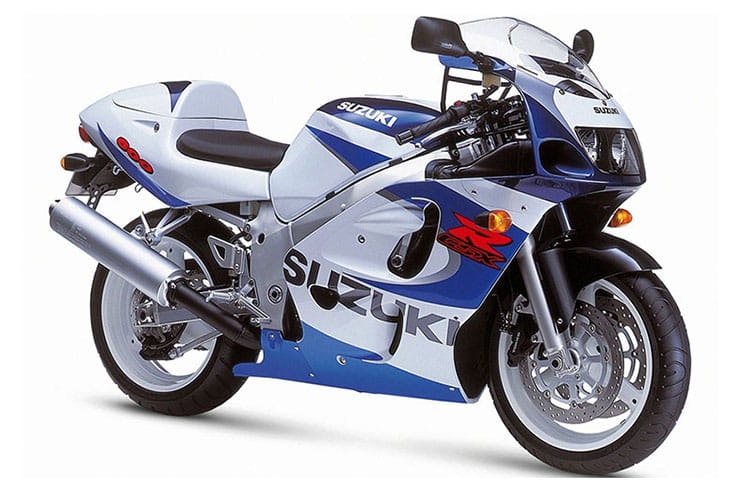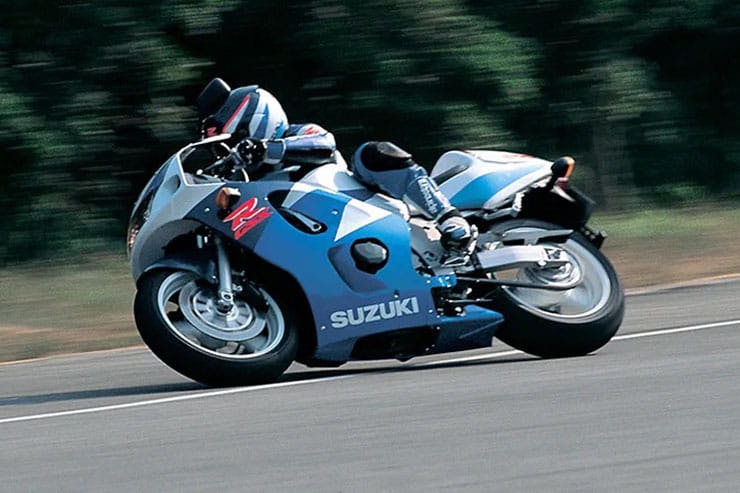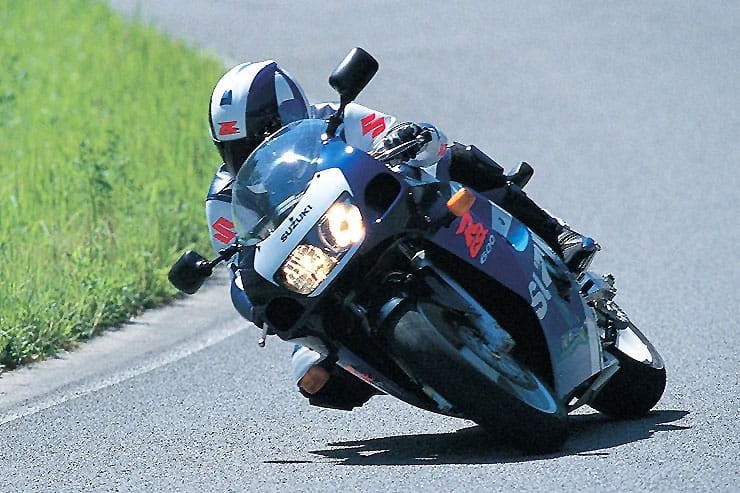Suzuki GSX-R600 (1997-2000): Review & Buying Guide
By Jim Moore
Bike journo for a quarter of a century
15.03.2024
Price: £1800-£3150 | Power: 106bhp | Weight: 186kg | Overall BikeSocial Rating: 3.5/5
Up until the arrival of the GSX-R600 in 1997 Suzuki’s middleweight offerings had been half-hearted to say the least. Both GSX600F and RF600R were more all-rounders or sports tourers than supersport scalpels. And even in their supposed do-it-all roles both bikes fell short of matching Honda’s jack-of-all-trades CBR600F.
The GSX-R600 was a different animal. Light, powerful, and focussed, it made no secret of the fact it borrowed heavily from Suzuki’s rejuvenated GSX-R750WT. When launched, the GSX-R was the sharpest, most focussed 600 the class had ever seen. Racers, trackday nuts and sports bike fans lapped up the middleweight GSX-R SRAD – much to Suzuki’s delight. Periodic updates followed, right up to the current model, with more power, less weight, and extra tech. But there’s a purity, focus and mischievousness in the original SRAD model that captures the very essence of what GSX-R means.
Two decades on the GSX-R600 is still a hooliganistic delight to ride (sorry, thrash). Finding one isn’t hard. With values starting at around £1800 they’re staggering value, too. Finding a good one that’s worth buying is the real trick. GSX-R owners love to personalise and modify their bikes (but not always for the better or to anyone else’s taste), so the hunt of a tidy nick, original as possible GSX-R600 is where it’s at. And here’s how to do exactly that.
Intense sportsbike experience with high rpm reward
Sharp handling – perfect for trackdays
Incredible value for money
Previous owners: many GSX-Rs are mercilessly thrashed and covered in cheap tat
Budget suspension is noticeably less sophisticated than a 750 SRAD
Average front brakes as standard
Suzuki GSX-R600 (1997-2000) Price
SRAD GSX-R600s sold from 1997 through to 2000, after which the revised K model took over. In the early 1990s Suzuki sold a bike called the GSX-R600 in North America, which was essentially a GSX-R750 sleeved down in capacity to match a then popular tax/capacity bracket.
1997 Suzuki GSX-R600R-V: Rough £1000-£1500; Tidy £1800-£2400; Mint £2600-£2800
Suzuki’s first genuine supersport offering. Based on the GSX-R750 SRAD platform – same frame, bodywork, dimensions etc, but with less sophisticated suspension. 599cc, 106bhp, 186kg. Colours: blue/white, red/black/graphite, black/blue
1998 Suzuki GSX-R600R-W: Rough £1100-£1600; Tidy £2000-£2500; Mint £2700-£2900
Lower screen height, various engine updates to improve midrange grunt and give a slight uplift to peak power. Graphics tweaked and blue/black options replaced by silver/black. 109bhp.Colours: blue/white, black/red, silver/black
1999 Suzuki GSX-R600R-X: Rough £1200-£1650; Tidy £2150-£2650; Mint £2800-£3000
Colour/graphics changes only. Colours: blue/white, yellow/black
2000 Suzuki GSX-R600R-Y: Rough £1250-£1700; Tidy £2250-£2800; Mint £2900-£3150
Last of the SRAD models before the introduction of the all-new K series. Colours and graphics changed, plus Alstare WSS replica paint option added. Colours: blue/white, red/grey, yellow/black, Alstare race replica
Suzuki GSX-R600 (1997-2000) Engine and Performance
The GSX-R600 engine is a thrasher’s delight, hiding its true potency until the upper reaches of its rev range. Peak power, a respectable 105bhp, plays its hand at 12,000rpm, some 2000rpm beyond peak torque (48lb.ft). So, if you want the best from a GSX-R600’s motor, you really have to work it. Mechanical sympathy brings little reward with this screaming Suzuki.
Unsurprisingly, the 600 borrows its engine architecture from the spectacular GSX-R750WT – the most powerful three-quarter litre superbike of its time. A right-side cam chain keeps the engine’s top end compact by allowing the cylinders to be placed closer together. Reducing size and weight was key to the GSX-R’s overall design, so even crankcase bolt heads were shaved down to the smallest and lightest possible size.
Other clever tech (for the time) to enhance performance and improve reliability include a special nickel/silicon/carbide coating on the bores, given the acronym SCEM (Suzuki Composite Electrochemical Material). Ram-air induction features too; SRAD (Suzuki Ram Air Direct), first seen on the GSX-R750WT, feeds pressurised air from intakes either side of the headlamps, through a large top mounted airbox and 36mm Mikuni Slingshot CV carbs into the combustion chambers. Flat-top pistons and a 12:1 compression ratio maximise mixture burn.
A slick six-speed gearbox transfers the engine’s output to the rear wheel. Despite the 600’s reputation as a thrash box, reliability is good, but regular servicing (fresh oil every 4000 miles) is a must. The GSX-R’s performance compares favourably against its rivals of the time, although the arrival of Yamaha’s R6 and Honda’s CBR600FX in 1999 and Kawasaki’s upgrade of the ZX-6R to 636cc for 2000 knocked the Suzuki down a peg or two by the end of the 1990s.
Suzuki GSX-R600 (1997-2000) Handling & Suspension
The GSX-R600 borrows its aluminium beam frame, tank, bodywork and dimensions directly from the 1996 GSX-R750WT – a superbike designed around the silhouette of the firm’s RGV500 GP racer. But with the fiercely contested 600 supersport class being a sensitive balance between performance and value for money, the smaller GSX-R came with less sophisticated (read less expensive) suspension.
Whereas the 750 runs fully adjustable upside down forks upfront, the 600 makes do with conventional telescopic forks (still 43mm), adjustable for preload and rebound only. Likewise at the rear, the 600 foregoes the 750’s heavily braced swingarm in favour of a simple box-section aluminium unit and a less sophisticated – albeit fully adjustable – single shock.
In terms of handling, the GSX-R600 turns-in and steers just as accurately and effortlessly as the 750 SRAD, thanks to shared steering geometry (24°/96mm rake/trail) and a trimmed to the bone dry weight of 174kg. That weight coupled with the bike’s 106bhp gives the GSX-R600 a power to weight ratio of 1.6kg per bhp – the best in class at the time.
If anything, the 600’s that bit sharper into a turn than the GSX-R750 due to its 10mm shorter wheelbase, which is all in the swingarm length – the more powerful 750 needs the extra length to keep its front wheel on the ground and aid high speed stability. The 600’s lower grade suspension is limiting, however, feeling less sophisticated than the 750’s,
The 600’s brakes are not on the same level as the 750’s either, being two pistons down on each side up front compared to the bigger bike. Suzuki’s didn’t overhaul the GSX-R600’s chassis until the arrival of the K model in 2001.
Suzuki GSX-R600 (1997-2000) What to look for
Downpipes/exhaust: The GSX-R600’s four-into-one exhaust system features mild steel downpipes and link pipe with an aluminium end can. Most original system will by now have rotted away or been replaced (hopefully with a stainless system). Aftermarket end cans are common, so make sure the carbs are jetted to suit.
Front brakes: On paper the GSX-R6’s front brakes look good: 2 x 310mm discs gripped by 4-pot Tokico calipers. But in practice, they lack bite – even from new. Braided hoses help, as do sportier pads (avoid organic pads). Like many calipers of the age, the Tokicos require a regular (try and make it yearly) deep clean and rebuild with fresh seals if required. Corrosion can get into the seal lands, lifting the seals and preventing the pistons from retracting properly. Left unattended this will eventually cause the discs to overheat and warp.
Aftermarket add-ons: GSX-R owners love aftermarket bolt-on parts. Some can be excellent, adding value and performance (quality exhausts, jet kits and suspension parts, for example). Often these extras are poor quality, however, devaluing a bike while adding no measurable benefit: coloured light covers, tiny indicators, cheap end cans, coloured screens, anodised bolts/footrests etc. Aim to be a GSX-R in original condition if at all possible, or one that wears quality parts – get the OE parts with the bike, too.
Previous owners: As touched on above, a bike’s previous owner can either be a blessing or a red flag. GSX-Rs were built to be thrashed and ridden hard, which is fine, but they also require fastidious maintenance and regular/thorough servicing if they’re to last and perform as intended. Service history is desirable but unlikely on a bike now 25-years-plus in age. Instead, ask who services it (the owner or a mechanic), what oil they use (quality semi-synth) and how often it’s given workshop time.
Cam chain: Can get rattly when the auto tensioner starts to wear. Left unattended it’ll only get worse or fail. Fitting a manual tensioner is a cheap and easy solution.
Suspension: The 600 may share its styling, frame and dimension with the 750 SRAD, but as a middleweight it was built down to a price and as such does not enjoy the bigger bike’s more sophisticated suspension. The 600’s 43mm telescopic forks offer preload and rebound damping adjustment; the shock is fully adjustable. Both were more adequate than amazing as standard, so by now they’ll be in need of an overhaul if that’s not already been carried out. A quality aftermarket shock, such as Maxton, Nitron or WP, is a sensible investment, as is a fork rebuild by a specialist. 750 SRAD usd forks will fit, but you’ll need the yokes and calipers too if you want that upgrade.
Corrosion: GSX-R600s can look very tatty very quickly if not looked after properly. The finish on the aluminium frame lasts well as long as the lacquer coating isn’t penetrated. Footrest hangers, shock preload collar, forks, calipers and brackets are all magnets for corrosion, however. Buying a bike in poor condition in the hope you’ll be able to restore it back to original in wishful thinking. Aim for the best example you can afford.
Bodywork: Likely to be showing signs of age and potential crash damage by now. Connecting tangs break easily, and aftermarket race replica paintjobs can hide a multitude of sins and damage. Fortunately 750 SRAD bodywork is a straight fit, even if the colours aren’t. Pillion seat and rear cover should come with the bike.
Suzuki GSX-R600 (1997-2000) Rivals
Honda CBR600F, 1997 | Approx Price: £1500-£2800
Power/Torque: 105bhp/48.6lb-ft | Weight: 186kg
Accomplished all-rounder that’s as competent as a sportsbike as it is as touring. Hugely popular back in the 1990s, and rightly so. Easier to live with than a GSX-R, but trackday riders may prefer the Suzuki’s uncompromising focus. Still amazing value and arguably the best quality and put together 600 of its era.
Kawasaki ZX-6R, 1997 | Approx Price: £1500-£2750
Power/Torque: 105bhp/47lb-ft | Weight: 187kg
Nearest rival to the CBR600F. A better all-rounder and more comfortable than the GSX-R, but still packs a sharp sporty edge. Later ’90s ZX-6Rs cost barely more, yet come with more power, improved chassis and even better ergonomics. Mild steel exhaust system likely to be rotten by now. Still worth a look if you can find a good one.
Yamaha YZF-R6, 1998 | Approx Price: £1500-£3000
Power/Torque: 110bhp/68lb-ft | Weight: 169kg
Brilliant supersport machine with the strongest engine in its class for the time, a razor sharp chassis and a build quality markedly better than most other 600s of the era. Tidy, original examples are getting rarer now – many have been crashed and thrashed – but should be on your list of you’re considering a GSX-R600.
Suzuki GSX-R600 (1997-2000) Verdict
Most old 600 sportsport models offer exceptional value for money. They represented that very thing when new and, due in part to their popularity and built-to-a-price nature, very few 600s have grown on value over the years. Whether you’re looking for something to thrash at the weekend, take on trackdays, or simply relive good times, there’s a GSX-R600 out there to suit all pockets.
Buy the best you can, however, because a GSX-R600 is all about the ride – razor sharp steering, searing top end performance and the ability to turn on a pin. Get one on fine fettle and you’ll have a blast, both literally and metaphorically.
Suzuki GSX-R600 (1997-2000) – Technical Specification
Looking for motorcycle insurance? Get a quote for this motorbike with Bennetts bike insurance


